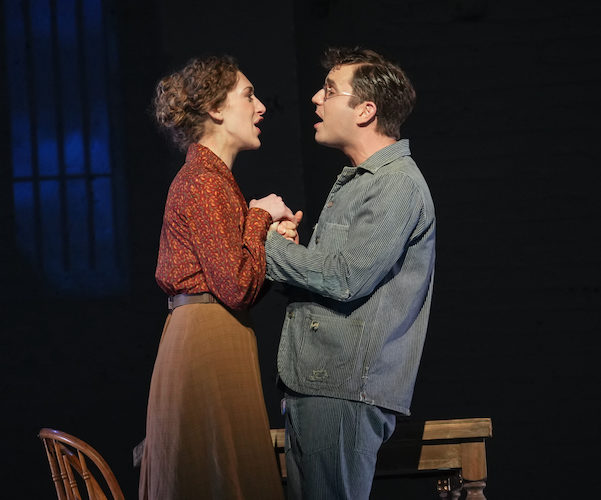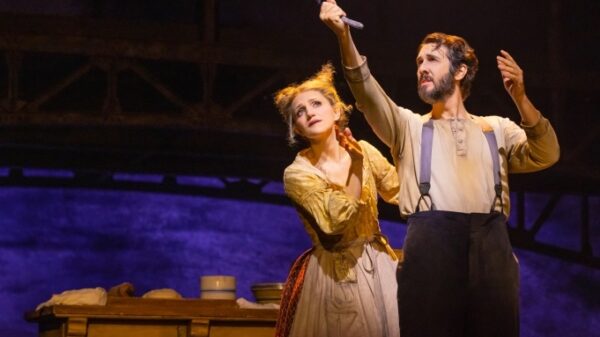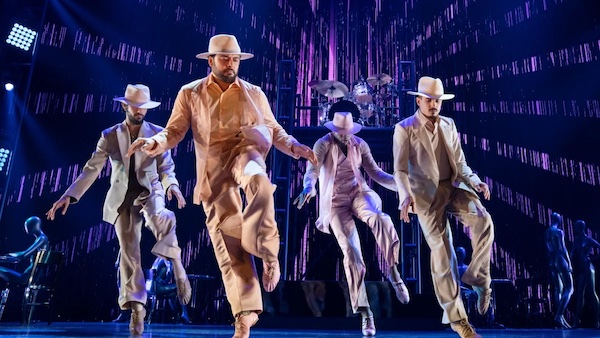Theater Reviews – This Broadway Season Welcomes Revivals of “Parade,” “Dancin’,” and “Sweeney Todd”
By Christopher Caggiano
Musical revivals are stealing the show on Broadway this season — some more successfully than others
One of the most competitive races at this year’s Tony Awards will undoubtedly be Best Revival of a Musical. So far this season, we’ve seen new mountings of Into the Woods, 1776, Parade, Bob Fosse’s Dancin’, and Sweeney Todd. In a few weeks, we will also see a completely revised Camelot, though the rumored changes are unlikely to constitute an entirely new show, given that the score remains the same.
The 1776 revival is unlikely to be nominated, as it fared poorly with critics and audiences alike (and deservedly so). Into the Woods seems like a lock. Even though the production has closed, it was extremely well reviewed and retained its many charms even with its numerous replacement castings. The production is currently in the middle of what seems to be a successful national tour.
And based on the critical reaction to Parade and Sweeney Todd, it seems clear those productions will receive nods as well. Whether Dancin’ is part of the pack will depend on how Camelot fares with the critics. (A special MVP nod goes to the Encores! program, which gave birth to both the Into the Woods and Parade revivals.)
Earlier this month, I had the chance to see Parade, Dancin’, and Sweeney Todd. Each production had its strengths and weaknesses, but for some the good far outweighed the bad.

Micaela Diamond and Ben Platt in Parade. Photo: Joan Marcus
Parade – To express anything but unbridled adulation for the musical Parade seems like sacrilege. The show is widely revered, and this revival has been rapturously received by both critics and theatergoers. Jason Robert Brown’s Tony-winning score has many willing elements, including smart and complex group numbers and soaring solo anthems. The story is razor sharp, thanks to the incisive focus in Alfred Uhry’s book and careful editing on the part of original director and co-conceiver of the show, the late great Harold Prince.
And yet.
Despite my lifelong devotion to musical theater — going on 45 years as of this writing — I can only muster up a begrudging admiration for Parade. The subject matter is certainly noble, centering around the miscarriage of justice surrounding the trial of Leo Frank for the murder of 13-year-old Mary Phagan. History is unclear on whether Frank was actually guilty, but there’s little question that his trial, conviction, and eventual fate were driven by anti-Semitism. And given the rising tide of sectarian violence in this country, this show is unfortunately more timely than ever.
So, the show is important, well intentioned, and well crafted. And the current production is lovingly and scrupulously staged. It’s hard to imagine the score ever being as well sung as it is here, led by Tony winner Ben Platt as Leo and Micaela Diamond as his wife Lucille.
But the fact is I simply don’t like Parade. Some people find the experience of watching Parade cathartic. I find it enervating. Sitting through the show for me is a chore, like I’m being forced to eat my vegetables. It’s not the tragedy that I object to. There are plenty of tragic musicals that I absolutely love, including West Side Story, Fiddler on the Roof, and Fun Home. The first act of Parade in particular is extremely unpleasant, both in terms of the proceedings and the treatment. Yes, I’m sure that’s intentional because this material is supposed to make the audience uncomfortable.
But I seem to recall from listening to the score that it’s a lot more melodic than the orchestrations of this production are allowing it to be. There’s a noisy, shrill quality to the soundscape of this production, which again could be intentional.
During act one, there’s not a single person on stage that seems sympathetic or worth rooting for, apart from Lucille Frank, although she only really comes into her own in the second act. The second half is considerably more engaging, which is ironic given the story ends tragically. By the end of act two, the characters have gone through their arcs so they are no longer as deliberately unlikable as they are at the beginning. The musical moments are also more sonorous and rounded.
But, in much the same way that I wish the fans of South Pacific well in their admiration for the show, an admiration that I personally do not share, so, too, do I wish the fans of Parade well. I do not happen to march among their number.

Annaleigh Ashford and Josh Groban in the revival of Sweeney Todd: The Demon Barber of Fleet Street. Photo: Matthew Murphy and Evan Zimmerman
Sweeney Todd, the Demon Barber of Fleet Street – I’ll admit that when Josh Groban was announced as the star of the latest Broadway revival of Sweeney Todd, I was extremely skeptical. I wasn’t impressed with Groban in Natasha, Pierre & the Great Comet of 1812, despite his Tony nomination. He really didn’t embody the role of Pierre, and his profundo voice didn’t match the contemporary style of the score. In Sweeney, his voice is far more idiomatic, and to his credit he actually loses himself in the role, handling both the mirth and the menace with aplomb.
Tony winner Annaleigh Ashford steals every freaking show she’s in, and this production is certainly no exception. Ashford is probably the most laugh-out-loud Mrs. Lovett we’re ever likely to see. Some of her physical shtick comes off as forced at times, more about garnering laughs than serving the drama. But she sings the role well and brings a great deal of pathos to the second act, especially in the moments that she has with Toby.
Probably the biggest distraction in director Thomas Kail’s otherwise top-notch production is the mannered and ridiculous choreography by Stephen Hoggett, who is also responsible for the unintentionally hilarious dance numbers for this season’s A Beautiful Noise. Now, Hoggett is a very talented man, but his background is in physical theater, not conventional choreography. He’s done remarkable work in musicals before, including American Idiot, Once, and The Last Ship, but he simply doesn’t have the vocabulary for a flashy showbiz piece like A Beautiful Noise. Sweeney Todd should really be more up his alley, but his work here is overly indicative, melodramatic, and just plain awkward.
Overall, though, there’s much to recommend this production of Sweeney Todd, including the 25-piece orchestra, an impressive physical production, and a powerful breakout performance by Gaten Matarazzo as Toby. Yes, that’s the kid who plays Dustin in Stranger Things. Matarazzo is not only charming and sweet in the role, but he also has a heck of a voice.

Bob Fosse’s Dancin’ at the Music Box Theatre. Photo: Julieta Cervantes
Bob Fosse’s Dancin’ – I’ve been obsessed with Bob Fosse since I saw All That Jazz in a movie theater in 1979. Soon after I discovered Pippin on home video, and I was completely hooked. But the only Fosse show I got to see live — at least while Fosse was still alive — was Big Deal, which, overall, was a fairly dreary affair, except for the dynamite act one closer, “Beat Me, Daddy, Eight to the Bar.” More on that number later.
When I taught a course in the history of dance in musical theater, I devoted a double unit to Fosse. In my research, I discovered two main things. First, Fosse numbers were often somewhat less than integrated into the story of their respective shows, especially the nearly irrelevant showstoppers he tended to place at the top of act two. Think “Who’s Got the Pain?” from Damn Yankees, “Steam Heat” from The Pajama Game, and “The Rhythm of Life” from Sweet Charity. Irrelevant, irrelevant, and irrelevant.
Also, Fosse didn’t play well with others, and throughout his career he continually shed collaborators to the point where he was eventually doing everything himself. Both of these Fosse peccadilloes led to Dancin’, which has no book or original score, so there were no collaborators for Fosse to fight with and no pesky story that he needed to shoehorn his dances into.
After the 1978 premier of Dancin’, legendary lyricist and librettist Alan Jay Lerner went up to Fosse and said, “Congratulations, Bobby. You got rid of the writer entirely.” In truth, there is some dialogue here, and plenty of live singing, but the words tend to be superficial and uninspired. But you don’t go to Bob Fosse’s Dancin’ for the character, the storytelling, or even the insight. You go for the Fosse.
Wayne Cilento, who was featured in the original production of Dancin’, provides direction and musical staging for the current production, although actual choreography here is obviously the Fosse original. Rather than slavishly recreate the original production, Cilento has chosen to retain the main set pieces and supplement them with various dance moments and numbers from other Fosse shows.
For instance, Cilento rearranges the order of the dances, moving the show’s original finale, “Sing, Sing, Sing,” to the beginning of act two and adding in “Beat Me Daddy, Eight to the Bar” from Big Deal as the new finale. Part of me would rather have seen an archival recreation of the original show, but I can see the impetus for making the show more of a Fosse tribute and retrospective, even though that was already done in 1999 with the Tony-winning revue Fosse.
You don’t necessarily need to know every dance in the Bob Fosse canon to truly enjoy Dancin’, but it certainly helps. The show works a bit like a jukebox musical, during which you smile or laugh when you hear your favorite songs in context. Here, there’s a similar joy of recognition here when you notice Cilento consciously quoting Fosse shows like Damn Yankees, Pippin, Sweet Charity, not to mention such well-known Fosse movies as Cabaret and All That Jazz, as well as lesser known movies like The Little Prince and My Sister Eileen.
The performers here are mostly dynamic and well trained, although some dancers didn’t seem to be dancing full out Fosse. He would likely have been livid at the lack of sharpness and the casual attitude with which some of the dancers approach his movement. Then again, Fosse was a heartless slave driver who barreled ahead heedless of human limitation. Perhaps it’s good we no longer tolerate dangerous choreography.
Christopher Caggiano is a freelance writer and editor living in Boston. He has written about theater for a variety of outlets, including TheaterMania.com, American Theatre, and Dramatics magazine. He also taught musical-theater history for 16 years and is working on numerous book projects based on his research.
